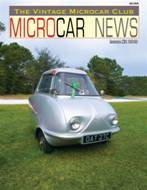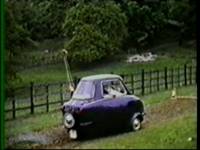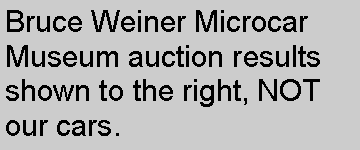








|
On July 19, 2013 we sold our Scootacars as a pair on ebay. This page was put together to go with the ad and tells our history with the Scoots. |


|
Instant Scootacar collection! Our silver Mk2 had a ground-up restoration, has won concourse awards & high praise. It was the cover story of 2009 Issue #2 "Microcar News". The blue Mk1 runs and is in good unrestored condition. Includes extra parts and lots of documentation. We would have to write a book to explain it all! Both cars have FL titles, registration & motorcycle tags.
The Scootacar is a very rare "Microcar", seen mainly in museums today. They were manufactured in England starting in 1958 by the Hunslett Engineering Company of Leeds. It was created by Henry Brown who had designed the Scootacar around the body of an occupant sitting astride the engine. The body was made from fiberglass and attached to a steel chassis that included a steel floorpan. The vehicle was advertised as having a "Car-sized door" and so access in and out of the Scootacar involved no crouching as was needed in other 3-wheelers of the period.
They were powered by a 2-stroke Villiers 197cc air-cooled engine. In the Mk1 version the driver sat astride the engine as on a motorcycle. In the Mk2 a new body was designed that included a car type chair for the rear passenger which was offset at 45 degrees. Approximately 1500 cars were produced but sadly by 1965 production stopped.Since they were indeed used for inexpensive transportation, they were often used-up and discarded. They were never imported into the US, so there are only a handful of them here brought over by enthusiasts.
Anyone reading this is probably already familiar with microcars, with the most famous being the Isetta and Messerschmitt. Microcars have now come to be a respected branch of the collector car hobby. On Feb 15/16, 2013, there was an auction of the contents of the world's largest microcar museum. This was the Bruce Weiner Microcar Museum in Madison, GA. It was conducted by RM Auctions. I just wanted to note here that the Scootacar Mk1 sold at auction for $39,100 and the Mk2, as it is even more rare, went for $50,600 This is a total of $89,700. I believe this to be the total price with auction fees, with the hammer price a bit lower. This information was found in the "Results" section for year 2013 at rmauctions.com
We have been to the museum several times. In fact, it was in 2001 when we first visited the museum that we first saw the Scootacars. With all the amazing cars there, somehow we liked them the best. That's what started us keeping an eye out for any opportunity to obtain one, as we relate in our History section below. In my opinion, the museum's Mk1 is in a little better condition than ours. However, the museum's Mk2 was in no way comparable to ours after our restoration. However, we understand that the auction was a very unusual situation, so we are offering our Scootacars at a far lower price than these auction results. |








|
History We bought the Scootacars based on nothing more than a few small photos on Alan Hitchcock's website in the UK. We had them shipped over and picked them up at the docks in Jacksonville July 25th, 2003. Please see our cover story article in 2009 Issue #2 of "Microcar News" which is available under "MORE RESOURCES" above right as a .pdf document. Jim has us telling our story with all it's ups and downs. Also in the "More Resources" area are links to additional Scootacar Mk2 & Mk1 photos. The Mk2 page shows lots of photos taken during the restoration. There are also links to photos from Microsouth 2008 where we have pictures with Dennis Gage and to a video which shows our Mk2 in a previous life at a "rally" (car show) in the UK, speeding through a game course. And please don't miss the bottom link which goes to a video showing the Mk2 driving up and down our street and pulling in the garage, which was just shot in March 2013.
While Scoot1 (our name for the blue 1960 Mk1) arrived ready to run and drive, Scoot2 (1965 Mk2) was in very bad shape. It was fairly complete, but useless without a complete restoration. So, we decided to start with Scoot2.
We spent 3+ years restoring it from the ground up. There was no part, nut or bolt that was not removed & improved. It took all of our time, weekends, vacations and nights to do it, as well as a continuous flow of money which got very much out of hand. In fact, we have spent more than $50,000. It wasn't until Feb of 2007, where we had it ready for our local Elliot Museum car show in Stuart, that it was truly done.
While it was an overwhelming project, it has been very gratifying showing it at microcar, concours and even general antique car shows. People have given it high praise and really seem to enjoy it. At Microsouth 2008, Dennis Gage was there. He was blown away with Scoot2 and we have his autograph on a photo of he & I with the Scoot, as well as pictures with him sitting in it. We were invited to show at the Hilton Head Concours d' elegance in Nov 2008, where we received the Palmetto Award.
Scoot2 Description If you have seen our Mk2 in person at car shows, you know that it is nearly perfect. Ken Caskey of Kidd Darrin's Restorations in Melbourne, FL did all the bodywork. The door was cracked in half so he reconstructed it while forming both it and the body's door opening to match perfectly. The metal frame in the Scootacar turns up at the edges and is embedded into the fiberglass body. Well, this metal of course was all rusted. So, when it was time for reconstruction, we decided to actually make the body separate from the frame. Now it is possible to take out several bolts and totally remove the body if it were to become necessary. Our goal was to keep the Scoot as original as possible, but be more sound and serviceable than anything they could have imagined when it was made. Ken also created many new pieces, such as the rear seat wrap-around support, which had very much disintegrated. The muffler was cosmetically all wrong, so I sliced it up to see what was inside and Ken created one from scratch that had the same internal structure but matched our collection of brochures and pictures externally. Does any other Scootacar have a $750 muffler?
- The actual floor was rusted badly, but the box-formed structure was in decent shape. We had a new floor made using the old rusted one as a pattern. This was welded to the structure.
- Ken reshaped the badly cracked door, fixed many problems with the body and incorporated new steel into the shell to allow it to be bolted to the floor. He recreated the rear seat surround and armrest. Also new wheel wells. The original windshield glass was in good shape, so only the rubber surround that holds it in was replaced. The rear window is plexiglass and was looking old, but Ken restored it and put it back in, of course with new rubber.
- Scoot2 is painted silver. We went to great lengths to find a silver with small grains so it would resemble the early silver paint as used by Scootacar and other british cars at the time. It is a beautiful paint job with clear coat.
- The electrical system in the Scootacar was very primitive, as it was in many british cars from the era (or any era?). It had NO fuses! It relied on early motorcycle batteries' relatively high series resistance (and maybe a prayer) to keep any short from setting the car on fire. I'm an electrical engineer, and this is one area where I could personally make sure everything was perfect. I redesigned the entire electrical system in CAD (which I can pass on to the new owner on paper and in the form of a .pdf document). I used this schematic to create a completely new harness. Now the car has a fuse block and master battery cut-off switch. The battery resides in a motorcycle type battery holder to protect the Scoot from any potential leaks. Since aesthetics dictated I use all the original dash switches, I took them all apart and used a shaker parts cleaner to clean all the brass contacts & terminals. I cleaned and polished the rest of the switch and put them all back together.
The ignition keyswitch was not working. It is special in that if pushed while starting, it starts the engine backwards in order to go into reverse. I got rid of it, and used a modern marine keyswitch, which fit the dash perfectly. In order to duplicate the original operation, I designed a printed circuit board with some small relays which makes use of the push-for-choke feature of the new keyswitch to establish reverse start-up. This small module is fully documented and completely out of view in the car (I have the same thing in Scoot1). The wiring is wrapped with heat-shrinking self-clinging silicone tape. The tail-light lenses are slightly different, but both are original from the time period, one being the replacement for the other. The base & sockets are new and match the originals perfectly but were only available with unrelated lenses which were discarded. The high-mounted turn signals are the original lenses, brought back to life & color by Ken. I created new base/socket assemblies for them.
- The wheels are the original split type that have been restored. The hubcaps are stainless reproductions on the front, and I took the best of the original aluminum ones and put it on the rear.
- The wiper motor is a new unit modified to look like the original.
- We restored the seats frames and created new cushions and upholstery, providing a new-car smell instead of the old-horse smell from the original horse-hair cushioned seats. If you want that experience, you can always get in Scoot1 and take a whiff!
- The interior is painted with speckled gray trunk paint, which we are assured is what they used originally. The parcel shelf was in decent shape and was blasted/painted and restored with new edging, carpet & an interior lamp switch which was a good match of the original.
- The entire brake system was replaced with the exception of the backplates and drums themselves, which were restored. The master & slave cylinders, all brake lines, hoses & fittings are new. The brakes are actually the same as a Morris Minor from the time period. Always use Castrol GT-LMA brake fluid in antique european cars.
- All the control cables are new.
- There is a modern fuel shut off valve under the rear seat instead of the original type which leaks.
- The majority of hardware that was replaced is stainless. Also, I had made in the UK brand new front & back aluminum plates that were identical to the originals.
- While we were at it, we built in tie-down points to make it easy to use ratcheting straps w/hooks to tie-down the car when transporting on a trailer. In addition, we have made a rather elaborate 2-stage car cover which protects Scoot2 on a trailer, and have built-in provisions for the straps on the underside of the car. Please see the "Microcar News" article in "MORE RESOURCES" for photos that demonstrate this capability.
With all that is right with Scoot2, I want to give you a list of what still needs to be done:
1) Recently, the dynastart, which is both the alternator and starter motor (as in the Messerschmitt), has been working intermittently. During engine restoration, we purchased either a used one in good condition or NOS dynastart, I can't remember which now. We had Wes Scott, who has a British motorcycle shop in Ft. Lauderdale, do the restoration of the Villiers engine. We took the dynastart to him during restoration and he installed it. It all worked fine at the time, but it needs attention now. My thought is that it might be better to have it rebuilt than try another used/NOS part.
2) The neutral light on the dash does not work. This is probably due to a small switch contact in the engine, and should be addressed when fixing the dynastart.
3) The speedometer cable is not installed, though we have the original. It requires a small adapter in-line at the engine end, and we had never gotten around to that.
4) The rear fender/mudguard, which you can't normally see unless you get down to the ground, is made of fiberglass and cracked early on and is currently not installed. It needs to be repaired and possibly have it's mounting holes moved a little.
Scoot1 Description Our Mk1 is still pretty much the way we received it when we shipped the pair over from the UK. Ideally, to match the Mk2, one would do a complete nuts & bolts restoration. However, the car is in good enough condition that a rolling restoration might be considered. Everyone seems to agree, though, that the horse hair seat cushions have got to go! The only thing needing immediate attention is the left front brake, which locked up the last time we drove it. For everything else, please just look over the photos and you should get a good idea of the condition.
Extra Parts & Documentation At the bottom of the photos section there are shots that show boxes with extra parts. Some parts are for the future restoration of Scoot1, such as a very nice NOS turn signal switch which is a long lever that comes out of the dash with a place for a bulb at the tip. This and many other parts are in one box. In the other are some original parts that were replaced, but I have kept them as a physical reference. For documentation, we have folders full of receipts, measurements, electrical system parts data, the new schematic I mentioned above, etc. We have a folder where we have kept all the paperwork from the acquisition, shipping & registration. We have manuals for the Villiers engine, which is an absolute must. We have copies of the original Scootacar Mk1 & Mk2 owner's manuals, which are just typed sheets. The elaborate custom car cover we made for Scoot2 (shown in the magazine article) will be included. It has 2 layers and is designed to allow transporting Scoot2 on an open trailer while keeping it perfectly safe. We do have memorabilia from the time which we intend to keep, but would be happy to make copies for the new owner.
|








































































